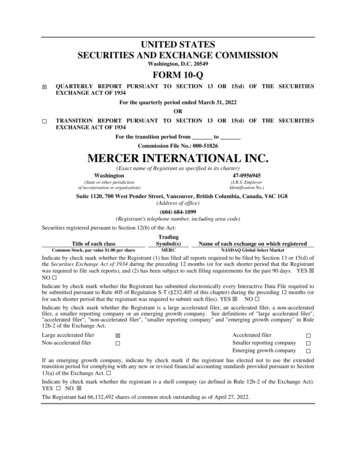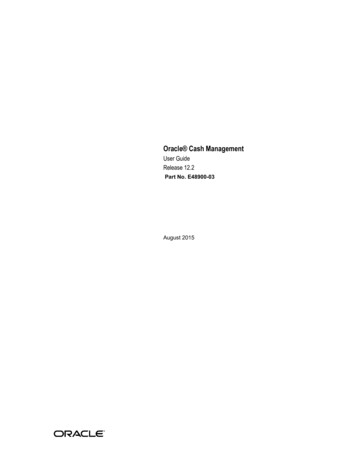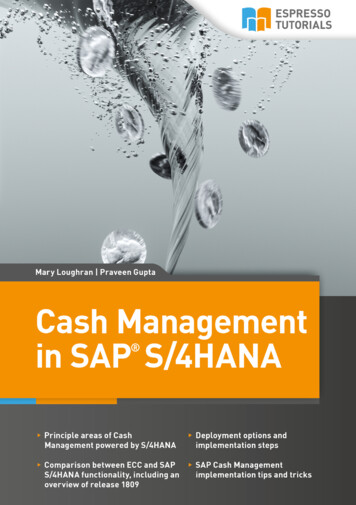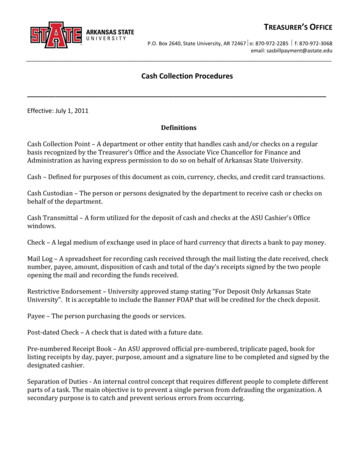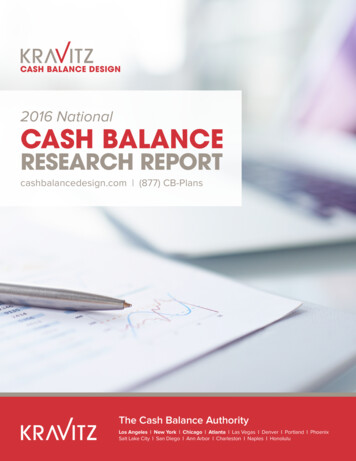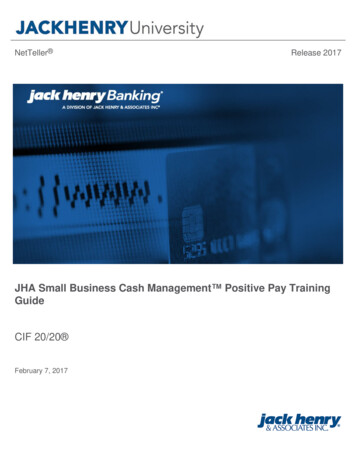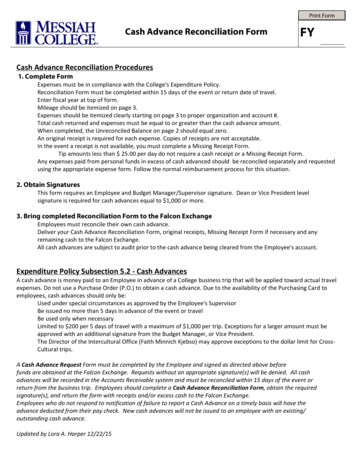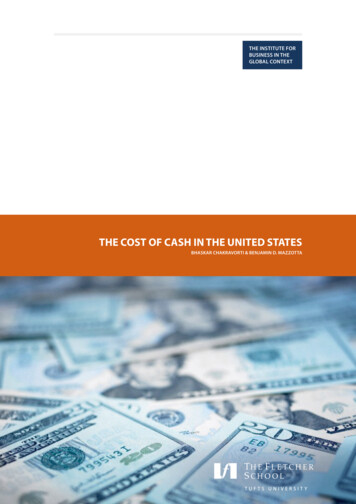
Transcription
THE INSTITUTE FORBUSINESS IN THEGLOBAL CONTEXTTHE COST OF CASH IN THE UNITED STATESBHASKAR CHAKRAVORTI & BENJAMIN D. MAZZOTTA
iiTHE INSTITUTE FORBUSINESS IN THEGLOBAL CONTEXTTHE COST OF CASH IN THE UNITED STATESPart one of a series on the cost of cash around the world, includingEgypt, India, and Mexico.September 2013
iiiACKNOWLEDGMENTSThe authors are grateful for the support and counsel of their colleagues and sponsors.Without the advice and critiques of many distinguished experts, this work would nothave been possible. The views expressed in this report and any remaining errors are theauthors’ alone. A special thanks to Barbara Bennett, Scott Schuh, Oz Shy, Joanna Stavins,and Tamas Brigelvics of the US Federal Reserve; Gonzalo Santamaria, Trish Halligan, Richard Haycock, and Robynn Haycock of Currency Research; Eugenie Foster; Kim Huynh,Carlos Arago, and Chris Foster of Bank of Canada; Jim Pitts of Financial Services Roundtable; David Wolman; Yuwa Hedrick-Wong, Mike Angus, Pilar Ramos, and Hemant Baijalof MasterCard Worldwide; George Smirnoff of Morgan Stanley; Michal Polasik ofNicolaus Copernicus University; Patricia Hewitt of Mercator Advisory Group; KevinMellyn of MPayMe; and from The Fletcher School, Kim Wilson, Nicholas P. Sullivan,Jenny Aker, Stacy Neal, Juan Arce, and Katrina Burgess.
ivAUTHORSBhaskar ChakravortiSenior Associate Dean for International Business and FinanceThe Senior Associate Dean of International Business and Finance at The Fletcher School,Bhaskar Chakravorti is also the Executive Director of Fletcher’s Institute for Business inthe Global Context and a Professor of Practice in International Business. Dean Chakravortihas extensive experience in academia, strategy consulting, and high-tech R&D. Prior toFletcher, Dean Chakravorti was a Partner at McKinsey & Company and a DistinguishedScholar at MIT’s Legatum Center for Development and Entrepreneurship. Chakravorti hasalso served on the faculty of the Harvard Business School and the Harvard UniversityCenter for the Environment.Benjamin D. MazzottaPostdoctoral Research Fellow for Inclusive GrowthDr. Benjamin D. Mazzotta is a Postdoctoral Research Fellow for Inclusive Growth at theInstitute for Business in the Global Context, where he works on the Cost of Cash study,which analyzes how cash payments affect a broad array of economic stakeholders indifferent countries. Dr. Mazzotta has held a number of research positions within TuftsUniversity and elsewhere: with the Institute for Global Maritime Studies, the Space PolicyWorking Group, the Cultural Change Institute, the University of Duhok’s School of Economics and Business Administration, and the US Cyber Consequences Unit (US-CCU).EditorsMelita SawyerJamilah WelchResearch AssistantsAyesh AriyasingheQuang TruongKimberly CorcoranRavi ChaturvediBetsy Ness-EdelsteinNikhil JosephInstitute for Business in the Global ContextThe Fletcher School, Tufts University
vABOUT THE INSTITUTE FORBUSINESS IN THE GLOBAL CONTEXTThe Institute for Business in the Global Context (IBGC) connects the world of businessto the world. It is the hub for international business at The Fletcher School at TuftsUniversity, the oldest exclusively graduate school of international affairs in the UnitedStates. The Institute takes an interdisciplinary and international approach, preparingglobal leaders who can cross borders of many kinds and integrate business skills withessential contextual intelligence. The Institute is organized around four core activityareas: education, research, dialogue, and a lab. The Master of International Businessdegree and executive education offerings, coupled with original research in the areasof inclusive growth, innovation, and global capital flows, facilitate vibrant conferences,symposia, and speaker dialogues.IBGC gratefully acknowledges support from The Bill & Melinda Gates Foundation, CitiFoundation, Chicago Bridge & Iron, The Global Fund, Hitachi Corporation, HitachiResearch Institute, K&L Gates, MasterCard Foundation, MasterCard Worldwide, OliverWyman, The Rockefeller Foundation, Dr. Thomas Schmidheiny, State Street Corporation,and Tata Group.
THE INSTITUTE FORBUSINESS IN THEGLOBAL CONTEXTTHE COST OF CASH IN THE UNITED STATESBHASKAR CHAKRAVORTI & BENJAMIN D. MAZZOTTAAcknowledgments . iiiAuthors. . .ivAbout the Institute for Business in the Global Context.vIntroduction. 3Consumer Study: Overview and Findings. . . 9Business Study: Overview and Findings. 25Government Study: Overview and Findings. 31Salient Findings and Implications. 37Bibliography. . . 41Appendix 1: Consumer Cash Habits. 45Appendix 2: Merchant Study. . . 57
RAI STONESStone discs were used as a formof currency on the island of Yap
IntroductionINTRODUCTIONOn the island of Yap, in the Western Pacific, large discs made of limestone — some up to 12 feet in diameter — were used as form of currency forimportant social transactions such as marriage, inheritance, political allianceand, in times of great need, in exchange for food. Most of the time, theseheavy stone discs did not change hands; everybody in the village just acknowledged that the stone had a new owner. The stone need not even beon the island to be regarded as something of monetary value. Once upon atime, according to Yap lore, a stone disc was lost at sea by a crew bringingit back from a limestone quarry on another island. Everyone on the islandaccepted the crewmen’s account that the stone lay at the bottom of the seaand so, granted someone’s claim over its value. This stone, or the idea of it,was thereafter considered good money and accepted as fair compensation.1Money is an abstraction built on trust. As such, alternatives to the most tangible form of money — currency or cash — and its replacement with cashlesspayments have become possible. Such an ecosystem is one where no transaction requires money in the form of notes and coins, and where value can beexchanged through the transfer of information between transacting parties.There have been multiple waves of such alternatives. Established alternatives to cash include checks, credit cards, debit cards,MONEY IS AN ABSTRACTIONand prepaid debit cards. More recently, innovative opBUILT ON TRUST.tions have sprung up that not only threaten to imperilthe ubiquity of cash but also upend the traditional payment ecosystem. These include smartphone-enabled credit card acquirers,such as Square, and Automated Clearing House or ACH acquirers, such asPayPal and Dwolla. And then there are even more ambitious alternatives tocash that have been proposed, such as Bitcoin, a web-based cryptocurrency.Unlike traditional money, such alternatives do not derive their value fromgovernment fiat. Each of these alternatives have evolved networks withinwhich they are uniformly accepted as a means of payment; the more established alternatives, of course, have the widest networks.This study starts from a simple observation: cash derives its value from theinformation it contains and is a classic information good, which can be replaced by a digital substitute.212William Henry Furness, Island of Stone Money, Uap of the Carolines (Philadelphia: J.B. Lippincott Company,1910).Hal R Varian, “Markets for Information Goods,” October, 1998; Carl Shapiro and Hal R. Varian, InformationRules: a Strategic Guide to the Network Economy (Harvard Business Press, 1999). 2013 THE FLETCHER SCHOOL OF LAW AND DIPLOMACY, TUFTS UNIVERSITY3
4THE COST OF CASH IN THE UNITED STATESToday most information goods with a sufficiently developed digital substitute have been disrupted anddisplaced. Cash, however, is different from the usual examples that spring to mind: communication, music, movies, and, increasingly, books. Money in the form of cash is a tangible embodiment of value. Cashis itself nothing more than a promise to pay: a completely interchangeable, transferable promise to paythe bearer. The purpose of money is to have stored wealth on hand for purchases today and tomorrow.Individuals derive a certain utility from holding cash that stems from many factors combining rational,behavioral, institutional and emotional drivers. That said, cash must be held in physical form, counted,guarded, and accounted for. It can be difficult to transport and send. Being possibly the last thing you canexpect to recover from a stolen wallet, acceptable everywhere, and anonymous, it is inherently insecure.In any serious quantity, most legitimate businesses prefer some other party, such as a bank, to handle cashon their behalf. In other words, cash satisfies two of the most significant criteria of digital disruption: thereare viable digital alternatives with wide networks of adopters and cash presents the carrier with multipleforms of disutility or costs.This begs the questions: why has cash not been completely displaced, what are the costs and benefits ofits continued use, and what are the implications for innovation in the use of cash and its alternatives?There are many factors that account for the continued prevalence of cash use:First, there is a powerful force of habit and inertia that helps lock in behaviors and expectations, particularly when there are multiple stakeholders involved. Both parties to a transaction must be plugged intoa compatible network. Both the payer and the payee must have compatible payment accounts, whetherwith depository institutions, issuing and acquiring banks, or disruptive innovators such as Bitcoin andPaypal. If payer and payee do not have compatible accounts, third parties such as check cashing storesmust stand in for one of the counterparties’ depository institutions. Merchants are used to processingpayments in the same way their customers are used to paying for them. Everyone finds the status quoconvenient and can be assured that all stakeholders accept cash as a legitimate form of payment. Adopting a new payment interface, whether it involves a new interface for an existing account or a new set ofhardware to acquire payments from familiar payment cards, entails new behaviors, risks or expectationsthat merchants and consumers are ill-equipped to assess.Second, network effects are hard at work in endowing money with value. Because more or less everyoneaccepts it — including the government and banks — money is the natural way to denominate prices in theeconomy. Cash can, in principle, be used to buy, well, anything that money can buy. The origins of currency notes are in promises to redeem the notes for something scarcer still: a quantity of precious metal, or anamount of money issued by a different authority. But with the closure of the gold window in 1973, moneybecame a snake biting its own tail, a promise to repay the bearer with an abstraction, a dollar is, ultimatelyanother identical currency note. Cash represents the ultimate guarantee to all sides of the transaction. Ina way, holding cash provides a sense of comfort and assurance, which is an important consideration forconsumers who wish to have a certain minimum amount of cash. 2013 THE FLETCHER SCHOOL OF LAW AND DIPLOMACY, TUFTS UNIVERSITY
IntroductionTHE CENTRAL INCONVENIENCE OF MONEYIS ITS VERY PHYSICAL MANIFESTATION.Third, cash gives the spender a sense of control over spending and visibility over how much of a budgethas been expended. This feature is convenient not just for the spender but also for others who care aboutthe spender’s budget — for example, parents who wish to establish limits on their children’s spending.Fourth, cash offers anonymity and financial privacy. This feature is a strong motivation for many consumers who do not wish to establish a traceable record for their personal transactions in general or forparticular purposes.Fifth, there are multiple alternatives to cash, ranging from credit cards and checks to mobile paymentsservices, among others. The field is quite fragmented, particularly for newer alternatives, which createsbarriers to adoption, since every potential adopter may worry about whether they can reliably use theoption as a substitute for cash in a sufficiently wide variety of transactions.Sixth, in order to truly see cash replaced with alternatives, key traits of the tangible features of currencywould have to be replicated. Something or someone would have to ensure that when an e-dollar enteredone person’s wallet, it also left the wallet of some other person. An e-dollar, shouldn’t be allowed to bein two places at once, but there are very few examples of such technology in the world. By default, mostcomputer files can be copied. If one copy of an e-dollar exists, as many copies of that e-dollar as one mightwant can be created. A whole field of cryptography undergirds the software used to decide whether or nota book can be read on a specific Kindle, whether or not a song can be played on a specific iPod. Attemptsto circumvent that digital rights management (DRM) software are a felony, and the subject of contentiousdebate on college campuses and in Congress. The technology to implement DRM, essentially a systemof cryptographic locks, on every e-dollar in the economy is just not there yet. And there is good reasonto suspect it never will be. DRM is highly contextual: it only works within a given ecosystem of softwareused to read and play the files. It also depends on a central database of permissions that decides whetheror not to allow the file to be read. So aside from the bandwidth and hardware requirements that wouldbe necessary to create true digital money, the anonymity of cash would also have to be compromised. Adollar bill has no idea who is holding it. But a system of digital payments, such as mobile money, cannotoperate independent of the notion of account holders, at least not today. Mobile money systems, for all themetaphors, behave much more like bank accounts than they do like money itself. So with digital innovation one must be on guard against misnomers and false analogies.Seventh, major factors that get in the way of scaling up alternatives to cash, such as mobile paymentsystems, are the regulatory constraints and the separate silos within which the relevant industry players — banking services, telecommunications, software, retail — operate. Mobile payments require a degreeof cooperation across these industries. Such coordination and agreement is difficult to orchestrate. 2013 THE FLETCHER SCHOOL OF LAW AND DIPLOMACY, TUFTS UNIVERSITY5
6THE COST OF CASH IN THE UNITED STATESIn summary, cash has several benefits and there are switching costs that deter users from turning to alternatives and displacing cash altogether. Currency retains several appeals as a means of payment, onlysome of which will be replicated by innovators. It requires no intermediaries; any two counterparties cancome together face to face and transact with precision and speed. It is anonymous as it bears no record ofthe user’s identity. All other payment systems are based on account balances tied to identities. There isno mobile money or other digital solution on the market today that provides the same type of anonymity cash provides. Cash is tangible, and bearers get constant feedback about current balances (providedbalances are small). Transactions are usually instantaneous, and once money is handed over the remaining balance is visibly lessened. This constant feedback about remaining balances can be leveraged forany variety of purposes, such as sticking to a budget or reinforcing the pain of spending. Because digitalsignals can be replicated, there is no such thing as a unique copy of a file that can replicate this tangible,anonymous, and disintermediated store of value in the same way that a coin and a currency note can.On the other hand, the central inconvenience of money is its very physical manifestation. Because moneyis somewhere, it must be brought somewhere else in order for a payment to be completed. No fax machine or website shopping cart can move the money from your wallet to the merchant. Bills distributedby mail take pains to warn the payer not to remit cash by mail, since the cash might be lost in transit. Inorder to transact in cash, two counterparties must arrange to meet face to face, or entrust a courier withthe cash for delivery. These costs of travel, and the risks of loss, make cash seem hardly an ideal mediumof payment. And yet cash comprises a large proportion of transactions in the economy, and not only in thepeer-to-peer space where electronic payments were (until recently) expensive to accept.So, then, what benefits can be gained from continued use of cash, and what costs might push users tomore widely adopt alternative payment methods? This report is part of a larger study, performed by TheFletcher School at Tufts University’s Institute for Business in the Global Context (IBGC) that seeks to ascertain the private costs and risks of cash management facing each of a set of stakeholders in the Americaneconomy: consumers, firms, the government, and also financial institutions. It does not intend to evaluatethe likelihood of cash use falling to a given level. Unlike much of the academic work previously donein this area, which focuses explicitly on the analysis of social costs with a view to inform public policy,IBGC’s approach uses opinion surveys to collect data from stratified samples of American consumers andmerchants to understand the real costs and risks they face as private actors in their usage of cash. Thefindings are then integrated with estimates based on secondary research and analyses. 2013 THE FLETCHER SCHOOL OF LAW AND DIPLOMACY, TUFTS UNIVERSITY
IntroductionFigure 1 provides a summary of the cost of cash to various stakeholders. The estimates below are based onhighly conservative assumptions. On aggregate, the cost of cash in the United States is 200 billion annually.FIGURE 1. COST OF CASH SUMMARYAnnual Cost of Cash in the United States Stakeholder, Breakdown250101USD, billions2001505510043500GOVERNMENTTax Gap (25%)Cash OperationsNew CurrencyBUSINESSATM OperationsNew Branch CostsBank RobberiesRetail TheftArmored CarsHOUSEHOLDSHousehold TheftTime SpentAccount FeesATM Fees 2013 THE FLETCHER SCHOOL OF LAW AND DIPLOMACY, TUFTS UNIVERSITY7
PAYING FOR CASHConsumers spend approximately 28 minutes per monthtraveling to the point where they access cash.
Consumer Study: Overview and FindingsCONSUMER STUDY:OVERVIEW AND FINDINGSIntroductionConsumers invest considerable time and money in managing their personalfinances. Increasingly, as electronic payments — phone, card, and computer — continue to gain market share of payment transactions in the UnitedStates, the cost of cash transactions is increasingly unclear and the costs ofmanaging cash are rarely measured. As part of a larger initiative which seeksto understand the changing landscape of global payment systems, this studyattempts to document the “Cost of Cash,” hoping to understand the financial, time and productivity outlays associated with cash use in the UnitedStates for consumers, businesses, and governments.In order to understand the actual and perceived impact of cash on consumers, The Institute for Business in a Global Context (IBGC) conducted asurvey of 1,000 Americans. The questionnaire assessed how respondents obtained cash, how often they exchanged cash for checksor bank deposits, the aggregate cost of cash manageTHE COST OF CASH IS HIGHER FORment, and the determinants of those costs. This chapterPOOR AND UNBANKED AMERICANSwill describe the research design, and will then evaluTHAN FOR OTHER GROUPS.ate reported cash usage and aggregate private costs ofcash management, disaggregating the analysis of thesurvey’s findings by demographic and financial features. Finally, a simplemodel is proposed that could, based on the stylized facts of the survey’s findings, explain why the cost of cash management might vary with financialfeatures of the respondents.Study DesignIBGC’s study used random telephone digit dialing within contiguous blocksof 100 phone numbers and computer-assisted telephone interviews, with theassistance of an external vendor. The interview covered consumer behaviorand attitudes regarding the use of cash. The sample was stratified by income,racial self-identification, educational attainment, and urban centrality. Thetwelve-minute survey consisted of questions that covered the respondent’sdemographic and employment profile, portfolio of payment accounts, andspecific habits and perceptions related to cash use. Most answers wereclosed-form, requiring a multiple choice selection or a single number as aresponse. Key demographic questions are described in detail below. 2013 THE FLETCHER SCHOOL OF LAW AND DIPLOMACY, TUFTS UNIVERSITY9
10THE COST OF CASH IN THE UNITED STATESDEMOGRAPHICS AND EMPLOYMENT PROFILEThe survey collected demographic data including racial self-identification, educational attainment, andurban centrality. In addition, employment information such as employment status, and the paymentmethod for receiving income was collected. Respondents were asked if they had a bank account and ifthey used check cashing services. In this report, income source refers to how the respondent earns a living:through a job, help from friends and family, investment income, or various types of government support.Separately from the discussion of income source, respondents were asked to identify their occupation.This section of the interview also asked about financial access: meaning which commonly held assets therespondent had, such as a checking account and savings account.INCOME AND CASH SOURCESRespondents were asked about how they typically receive income and, separately, how they typicallyobtain cash. Distinct from the income source, these answers are referred to as the income instrument andthe cash source. Income instruments are paychecks, Direct Deposit, cash, and a few other choices. Cashsources are bank branches, check cashing stores, ATMs, employers, friends and family, or a few otherplaces where cash might typically be accessed.Additionally, respondents recalled recent cash access events in the past 30 days. For each event, therespondent was asked when the cash was received or obtained (in number of days past), the amountobtained (in dollars), the type of cash source (ATM, bank teller, employer, friend/family, etc.), the timerequired to get the cash (in minutes), the mode of transit used to get the cash, and the fees paid for thetransaction (in dollars), if any. For those that received income in cash, respondents specified how that cashwas typically stored: as hard currency on hand, in a bank account, on a prepaid or stored value card, witha trusted acquaintance, or in some other way.RISK PERCEPTIONSIS CASH SAFE?To estimate consumers’ risk preferences with regard to holding cash, consumers were asked whether theyfind some cash balances “too large.” Without suggesting any specific cause of risk (e.g., theft), a binaryyes/no answer was solicited regarding whether a sum could be too large to hold in cash. If yes, the consumer was asked how much and how best to handle the cash: deposit, entrust, spend, or give it (away).IS CASH NECESSARY?In order to estimate consumer’s perception of cash’s necessity, respondents were asked if there was “Athere a minimum amount of cash that you always try to keep on hand?” No specific scenario (such as anemergency fund, enough for a tank of gas, enough to settle an informal debt, etc) was given. This questionwas designed to estimate an observable consequence of obligatory (i.e., necessary) cash balances. 2013 THE FLETCHER SCHOOL OF LAW AND DIPLOMACY, TUFTS UNIVERSITY
Consumer Study: Overview and FindingsTotal individual and household cash balances, (i.e., the amount of cash in the wallet and in the house),were also assessed. Finally, respondents were asked about decision rules related to the cash balance:whether they had maximum or minimum preferred cash balances, and how consumers with preferredcash maxima avoid holding too much cash on hand.ANALYSISThe following sections describe the results of the logistic regressions that explain the likelihood of payingfor access to cash, the likelihood of traveling farther than average to obtain cash, and whether the costs ofcash are systematically higher among certain groups.Key FindingsThe consumer survey yielded three key insights: The cost of cash is higher for poor and unbanked Americans than for othergroups. Poor Americans who lack access to formal financial institutions carrylarger amounts in cash and pay the most fees in aggregate terms for cashaccess transactions. Well-banked wealthier Americans, on the other hand,report carrying far lesser amounts in cash, traveling less to access cash, andpay few, if any, fees. The costs of using cash do not accrue at points of sale. Since merchantsrarely provide discounts or surcharges for using cash at the point of sale, thecosts of cash manifest elsewhere in the lifecycle of cash. This could mean,among other things, costs that accrue as a result of the time or money spent inmaking trips to a bank, ATM, or fees to cash checks. Personal cash theft is a relatively minor problem for American consumers, who lose less than 500 million through such crimes, but pay close to 8billion dollars in fees for ATM transactions outside of their account-holdingbank’s network. This is an interesting contrast to the high costs that businessesbear from cash theft.Detailed FindingsWHO HOLDS CASH?Households generally carry small cash balances. The middle three quintiles of US households (those earning approximately 20,000 to 100,000 in annual income) report that they usually carry cash balances ofunder 100.The survey explored cash usage in detail, and found that the prevalence of cash in a household is correlated with key financial and demographic traits. Preferences for cash and for higher cash balancesdemonstrated a significant relationship with the traits explored in detail below. 2013 THE FLETCHER SCHOOL OF LAW AND DIPLOMACY, TUFTS UNIVERSITY11
12THE COST OF CASH IN THE UNITED STATESDEMOGRAPHIC TRAITS:The demographic traits of age, income, race, and gender had durable influence on cash holdings, perceptions, and costs.AGEAmericans under 35 have median cash balances roughly half those aged over 55, but pay more in feesthan older Americans. Several factors may be at work here. As individuals age, they are likely to earnmore and accumulate assets, and therefore they may simply have more money that could be held in cash.Additionally, older Americans prefer using bank tellers for transactions, a practice which typically carriesno fee. Consumers using check cashing, ATM cards, and types of cash advances may face higher chargesin some locations. Older Americans also access cash far less frequently, perhaps because of the temporaldistribution of income, reduced mobility, or long established habits.INCOMERicher Americans carry more cash in their wallets. Median cash balances for those earning over 60,000are about the same as those of people earning less than 40,000. Income correlates not only with age, butalso with higher levels of education. Furthermore, the rich tend to hold more different types of paymentinstruments, and to be more aware of the risks of accidental or malicious cash loss. Perceptions of the risksassociated with cash are explored in detail below.RACEAmong racial groups, Latinos, Pacific Islanders, and American Indians report much higher average maxima of cash holdings, as compared to white, African American, and especially Asian Americans. AfricanAmericans and Pacific Islanders are likely to hold minimum balances nearly double those of other groups.GENDERMen carry nearly double the amount of cash that women do. Men are slightly more likely to keep somecash always on hand than are women, and they use roughly 50% more cash per month than do women.FINANCIAL TRAITS:The financial traits investigated included: whether the household has access to formal financial institutions through a bank account, the types and sources of income the household receives, and the way inwhich the receive income, or payment instrument. They were found to be correlated with who holdshigher cash balances and who pays more for cash.BANKED STATUSThe unbanked access greater amounts of cash in a typical month than those with bank accounts. Thosewith bank accounts are roughly twice as likely to report that it is possible to hold too much cash. Theunbanked, meanwhile, report substantially higher ceilings on cash balances if they have them at all, inabsolute terms and not adjusted for income. 2013 THE FLETCHER SCHOOL OF LAW AND DIPLOMACY, TUFTS UNIVERSITY
Consumer Study: Overview and FindingsEMPLOYMENT STATUSSelf-employed and multiple job holders had the greatest cash balances (not adjusted for income), and theunemployed and those on disability held the least. Employees and the unemployed were the most likelyto report that it was possible to hold too much cash. Those receiving federal benefits, including SocialSecurity, were about half as likely as others to think it was possible to hold too much cash.INCOME INSTRUMENTThe payment instrument by which the consumer typically receives income can greatly affect the numberof cash access events required in a given month and the source of funds. Direct deposit transactions froman employer lend themselves very well to access via ATM, cash back transactions at the point of sale,and other compar
placed by a digital substitute.2 1 William Henry Furness, Island of Stone Money, Uap of the Carolines (Philadelphia: J.B. Lippincott Company, 1910). 2 Hal R Varian, "Markets for Information Goods," October, 1998; Carl Shapiro and Hal R. Varian, Information Rules: a Strategic Guide to the Network Economy (Harvard Business Press, 1999 .



